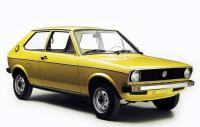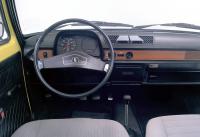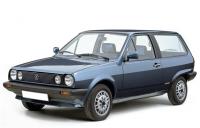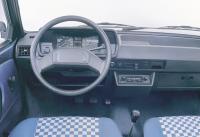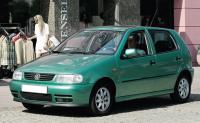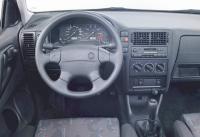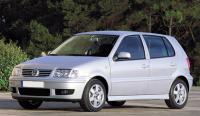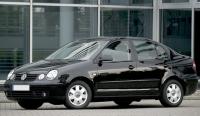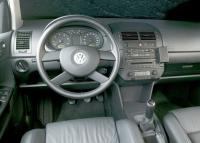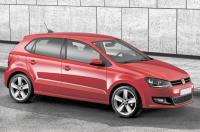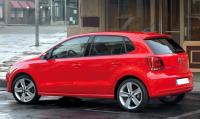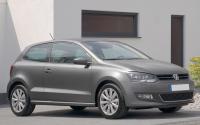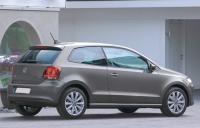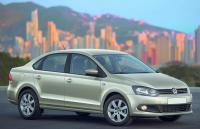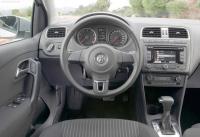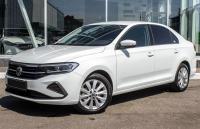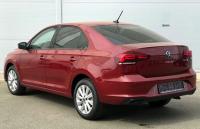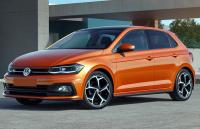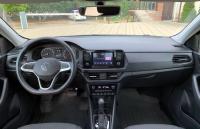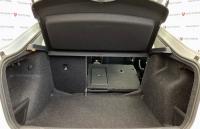Polo I (1975—1981)
The first generation Polo was released in 1975, replacing the Audi 50 car. It was cheaper than the Audi and therefore became much more popular. For all the time, about 500,000 copies were produced. All cars were produced at the Volkswagen plant in Wolfsburg. The body was of two types - a sedan and a hatchback, the interior decoration is not expensive and simple, a fairly large trunk with a volume of 260 liters.
The car had front-wheel drive with four-cylinder in-line gasoline engines located transversely and with a volume of 0.9, 1.1 and 1.3 liters with a capacity of 39, 50 and 60 hp. Liquid-cooled four-stroke engines with cast-iron cylinder block. Transmission only mechanical 4-speed together with a dry single-plate clutch.
The brakes were drums at the rear and disc brakes at the front. The rear suspension is semi-independent with a torsion beam, the front MacPherson type with anti-roll bar.
Polo II (1981—1994)
The world saw the second generation in September 1981. The car was manufactured at the same factory in Wolfsburg, but in the mid-80s, production was also established in Spain. A new body type has been added to the already produced sedans and hatchbacks - a 3-door station wagon. There were three types of complete sets - C, CL and GL.
The car gained popularity and by 1986 over two million copies of both generations had been produced. In total, over the 13-year period of production of the Polo II, 1.7 million cars were produced. The main competitors were Austin Metro, Ford Fiesta, Fiat Uno and Peugeot 205, but Polo stood out for higher reliability and build quality.
At first, the car was equipped with four-cylinder gasoline engines of 1.0, 1.1 and 1.3 liters with a capacity of 45 to 116 hp. In 1986, the first 1.3 and 1.4 liter diesel engines appeared (45 and 48 hp), but they were not in great demand. Suspension, braking system and steering remained the same.
In 1990, this model has undergone modernization. The biggest visual difference is rectangular headlights, a new grille, larger taillights, bigger bumpers and a new interior (door trim and dashboard). The chassis, suspension and braking system have also undergone modifications. All engines began to be equipped with catalytic converters.
Polo III (1994—2001)
This generation was completely new, assembled on the Volkswagen A03 platform. Production started in 1994 in Spain (Pamplona) and Germany (Walsburg), and in October the car was presented at the Paris Motor Show and went on sale. The shape of the car has become more rounded, which allowed to reduce aerodynamic drag and look more modern. Dimensions have increased slightly, body types are as follows - 3-door hatchback, 4-door sedan and for the first time appeared 5-door hatchback and station wagon.
The suspension has been significantly improved, despite the previous concept. This allowed to improve the behavior of the car when turning. It became possible to order a car with power steering. The brakes could also be ordered with the ABS option and electronic brake force distribution.
At first there were three gasoline engines - a volume of 1.0, 1.4 and 1.6 liters (50, 60 and 75 hp). Since 1996 they have been replaced by new 1.4 and 1.6 liter 16-valve engines (100 and 120 hp). The choice of diesel engines has expanded significantly. At first there were atmospheric diesel engines with a volume of 1.7 and 1.9 liters (60 and 64 hp), then in 1996, turbodiesels with direct injection of 1.4 and 1.9 liters appeared (75 and 90 hp).
New assembly plants in addition to the existing ones were opened: November 17, 1995 at a plant in the city of General Pacheco, Argentina; autumn 1995 at the plant in Martorell, Spain; in June 1999 at the plant in Bratislava, Slovakia.
In 1999, Polo 3 was upgraded. Immediately striking is the large emblem of the Volkswagen company on the trunk lid and grille. Airbags and ABS were added to the basic package, the quality of the interior trim was improved, and the body was reinforced.
Polo IV (2001—2009)
Unveiled on September 11, 2001 at the Frankfurt Motor Show, the fourth generation Polo is all brand new and shares a structural resemblance to the Golf IV. The external difference from the previous generation is four round headlights. All body parts are galvanized and the overall rigidity of the body is increased by one third. The interior space of the cabin has also increased, as well as the quality of the interior trim has improved. Body types were as follows - 3-door and 5-door hatchback and 4-door sedan.
The range of gasoline engines has expanded and included volumes from 1.2 to 1.6 liters (from 55 to 105 hp). A 1.8-liter turbocharged gasoline engine with a capacity of 150 hp also appeared. There were 3 types of diesel engines to choose from - one atmospheric 1.9 liters (64 hp) and two 1.4 turbodiesels (75 hp) and 1.9 liters (101 hp). All motors comply with the Euro-4 standard. There are two transmissions to choose from - a 4-speed automatic or a 5-speed manual.
By default, the brakes were equipped with an ABS system with electronic brake force distribution, as well as an emergency braking assistance system. All cars have ventilated disc brakes, except for models with engines less than 75 hp, they have rear drum brakes.
For the safety of passengers and the driver, height-adjustable seat belts with tension limiters, as well as enlarged airbags, are responsible. Side airbags are available as an option.
Polo V (2009—2017)
In March 2009, the production of the fifth generation Volkswagen Polo began and its production began at a plant in the city of Pamplona in Spain. In December, production began at a new plant in Pune, India. The design of the car is a continuation of the Golf VI corporate identity. The length has increased by 44 mm, the width has increased by 32 mm compared to the previous generation. Body types remained the same - sedan and hatchback. The center console has been completely redesigned, and the comfort of the cabin has also increased.
A wide range of petrol engines from 1.2 to 1.6 liters with power from 70 to 180 hp is presented. Diesel engines two - 1.2 liters (75 hp) and 1.6 liters (105 hp). Transmission is available as a 6-speed manual or 7-speed automatic preselective DSG. The chassis has not changed much, only design improvements have been made to increase stability and controllability.
The braking system, in addition to those already described above, is equipped with a stability control system (ESP), an uphill starting assistant and a differential lock simulation system.
Improved passive and active vehicle safety. Reinforced bumper, B-pillars and doors. Two front and two side airbags, front seat belts with pretensioners, and three-point seat belts for rear passengers are standard.
In 2010, Polo was awarded for the first time «European Car of the Year», and «World Car of the Year». Awarded for 2010-2011 «Japan Import Car of the Year».
Polo VI (2017— present _ in.)
The sixth generation of the Volkswagen Polo was presented in June in Berlin, and production began at the end of 2017. The car is based on a platform «VW MQB A0», which is also used for Audi A1, SEAT Arona / Ibiza, Skoda Kamiq / Scala / Fabia, Volkswagen Nivus / T-Cross / Virtus. The body is presented in two versions - a 5-door hatchback and a 4-door sedan. Body length was 4053 mm (hatchback) or 4482 mm (sedan), width 1751 mm and height 1438 mm. Body rigidity increased by 28% due to increased use of high-strength steels. As standard, the car is equipped with a forward collision detection system, a blind spot monitoring function and an emergency stop.
Gasoline engines are represented by the following models - three-cylinder atmospheric 1.0 liter (999 cm3, EA211, 65/75/80 hp), turbocharged 1.0 liter (999 cm3, EA211, TGI/TSI, 90/95/110/115 hp), four-cylinder turbocharged 1.5-liter (1498 cm3, EA211 evo, 150 hp) and 2.0 liters (1984 cm3, EA888, 200/207 hp). Diesel engines turbocharged four-cylinder volume of 1.6 liters (1598 cm3, EA288, 80/95 hp). Transmission 5 or 6 speed manual, 6 speed automatic and 7 speed dual clutch DSG.
In the fall of 2020, the model was restyled for the 2021 model year, the changes affected only the appearance of the car.

